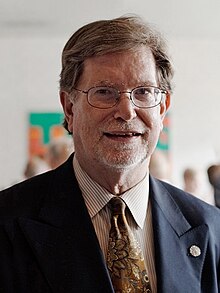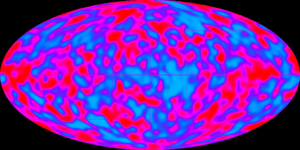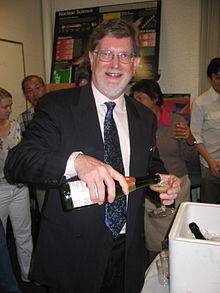| George Smoot | |
|---|---|
 Smoot at 2009 POVO conference in The Netherlands Smoot at 2009 POVO conference in The Netherlands | |
| Born | George Fitzgerald Smoot III (1945-02-20) February 20, 1945 (age 79) Yukon, Florida, U.S. |
| Alma mater | Massachusetts Institute of Technology |
| Known for | Cosmic microwave background radiation |
| Awards | NASA Medal for Exceptional Scientific Achievement (1992) Kilby Award (1993) American Academy of Achievement Golden Plate Award (1994) E. O. Lawrence Award (1994) Albert Einstein Medal (2003) Nobel Prize in Physics (2006) Gruber Prize (2006) Daniel Chalonge Medal (2006) Oersted Medal (2009) |
| Scientific career | |
| Fields | Physics |
| Institutions | UC Berkeley/Lawrence Berkeley National Laboratory/Paris Diderot University/Hong Kong University of Science and Technology |
| Thesis | Charge exchange of positive Kaon on platinum at three GeV/C (1971) |
| Doctoral advisor | David H. Frisch |
| Part of a series on | ||||
| Physical cosmology | ||||
|---|---|---|---|---|
 | ||||
Early universe
|
||||
| Expansion · Future | ||||
Components · Structure
|
||||
| Experiments | ||||
| Scientists | ||||
| Subject history | ||||
George Fitzgerald Smoot III (born February 20, 1945) is an American astrophysicist, cosmologist, Nobel laureate, and the second contestant to win the $1 million prize on Are You Smarter than a 5th Grader?. He won the Nobel Prize in Physics in 2006 for his work on the Cosmic Background Explorer with John C. Mather that led to the "discovery of the black body form and anisotropy of the cosmic microwave background radiation".
This work helped further the Big Bang theory of the universe using the Cosmic Background Explorer (COBE) satellite. According to the Nobel Prize committee, "the COBE project can also be regarded as the starting point for cosmology as a precision science." Smoot donated his share of the Nobel Prize money, less travel costs, to a charitable foundation.
Smoot has been at the University of California, Berkeley and the Lawrence Berkeley National Laboratory since 1970. He is Chair of the Endowment Fund "Physics of the Universe" of Paris Center for Cosmological Physics. Apart from being elected a member of the US National Academy of Sciences and a Fellow of the American Physical Society, Smoot has been honored by several universities worldwide with doctorates or professorships. He was also the recipient of the Gruber Prize in Cosmology (2006), the Daniel Chalonge Medal from the International School of Astrophysics (2006), the Einstein Medal from the Albert Einstein Society (2003), the Ernest Orlando Lawrence Award from the US Department of Energy (1995), and the Exceptional Scientific Achievement Medal from NASA (1991). He is a member of the advisory board of the journal Universe.
Smoot is one of the 20 American recipients of the Nobel Prize in Physics to sign a letter addressed to President George W. Bush in May 2008, urging him to "reverse the damage done to basic science research in the Fiscal Year 2008 Omnibus Appropriations Bill" by requesting additional emergency funding for the Department of Energy's Office of Science, the National Science Foundation, and the National Institute of Standards and Technology.
Early life
Smoot was born in Yukon, Florida. His maternal grandfather was Johnson Tal Crawford. He graduated from Upper Arlington High School in Upper Arlington, Ohio, in 1962. He studied mathematics before switching to physics at the Massachusetts Institute of Technology, where he obtained dual bachelor's degrees in mathematics and physics in 1966 and a Ph.D. in particle physics in 1970. A distant relative, Oliver R. Smoot, was the MIT student who was used as the unit of measure known as the smoot.
Initial research
George Smoot switched to cosmology and began work at Berkeley, collaborating with Luis Walter Alvarez on the High Altitude Particle Physics Experiment, a stratospheric weather balloon designed to detect antimatter in Earth's upper atmosphere, the presence of which was predicted by the now discredited steady state theory of cosmology.
He then took up an interest in cosmic microwave background radiation (CMB), previously discovered by Arno Allan Penzias and Robert Woodrow Wilson in 1964. There were, at that time, several open questions about this topic, relating directly to fundamental questions about the structure of the universe. Certain models predicted the universe as a whole was rotating, which would have an effect on the CMB: its temperature would depend on the direction of observation. With the help of Alvarez and Richard A. Muller, Smoot developed a differential radiometer which measured the difference in temperature of the CMB between two directions 60 degrees apart. The instrument, which was mounted on a Lockheed U-2 plane, made it possible to determine that the overall rotation of the universe was zero, which was within the limits of accuracy of the instrument. It did, however, detect a variation in the temperature of the CMB of a different sort. That the CMB appears to be at a higher temperature on one side of the sky than on the opposite side, referred to as a dipole pattern, has been explained as a Doppler effect of the Earth's motion relative to the area of CMB emission, which is called the last scattering surface. Such a Doppler effect arises because the Sun, and in fact the Milky Way as a whole, is not stationary, but rather is moving at nearly 600 km/s with respect to the last scattering surface. This is probably due to the gravitational attraction between our galaxy and a concentration of mass like the Great Attractor.
COBE

At that time, the CMB appeared to be perfectly uniform excluding the distortion caused by the Doppler effect as mentioned above. This result contradicted observations of the universe, with various structures such as galaxies and galaxy clusters indicating that the universe was relatively heterogeneous on a small scale. However, these structures formed slowly. Thus, if the universe is heterogeneous today, it would have been heterogeneous at the time of the emission of the CMB as well, and observable today through weak variations in the temperature of the CMB. It was the detection of these anisotropies that Smoot was working on in the late 1970s. He then proposed to NASA a project involving a satellite equipped with a detector that was similar to the one mounted on the U-2 but was more sensitive and not influenced by air pollution. The proposal was accepted and incorporated as one of the instruments of the satellite COBE, which cost $160 million. COBE was launched on November 18, 1989, after a delay owing to the destruction of the Space Shuttle Challenger. After more than two years of observation and analysis, the COBE research team announced on 23 April 1992 that the satellite had detected tiny fluctuations in the CMB, a breakthrough in the study of the early universe. The observations were "evidence for the birth of the universe" and led Smoot to say regarding the importance of his discovery that "if you're religious, it's like looking at God."

The success of COBE was the outcome of extensive teamwork involving more than 1,000 researchers, engineers and other participants. John Mather coordinated the entire process and also had primary responsibility for the experiment that revealed the blackbody form of the CMB measured by COBE. Smoot had the main responsibility of measuring the small variations in the temperature of the radiation.
Smoot collaborated with San Francisco Chronicle journalist Keay Davidson to write the general-audience book Wrinkles in Time, that chronicled his team's efforts. In the book The Very First Light, John Mather and John Boslough complement and broaden the COBE story, and suggest that Smoot violated team policy by leaking news of COBE's discoveries to the press before NASA's formal announcement, a leak that, to Mather, smacked of self-promotion and betrayal. Smoot eventually apologized for not following the agreed publicity plan and Mather said tensions eventually eased. Mather acknowledged that Smoot had "brought COBE worldwide publicity" the project might not normally have received.
Other projects
After COBE, Smoot took part in another experiment involving a stratospheric balloon, Millimeter Anisotropy eXperiment IMaging Array, which had improved angular resolution compared to COBE, and refined the measurements of the anisotropies of the CMB. Smoot has continued CMB observations and analysis and was a collaborator on the third generation CMB anisotropy observatory Planck satellite. He is also a collaborator of the design of the Supernova/Acceleration Probe, a satellite which is proposed to measure the properties of dark energy. He has also assisted in analyzing data from the Spitzer Space Telescope in connection with measuring far infrared background radiation. Smoot also was a leader in a group that launched the Mikhailo Lomonosov April 28, 2016.
Smoot is credited by Mickey Hart for inspiring the album Mysterium Tremendum, which is based, in part on "sounds" that can be extracted from the background signature of the Big Bang.
As of September 2019, Smoot is an artificial intelligence scientist for the GTA Foundation, whose business is storing genomic sequencing data and using it in scientific applications.
In November 2020, he joined Dead Sea Premier as head of research for their NUNA advanced technology anti-aging medical device development.
In April 2021, he joined the Xiaomi eco-system company Viomi as chief scientist for their AI-development.
In January 2023, George Fitzgerald Smoot III joined the National Council for Science and Technology under the President of the Republic of Kazakhstan.
Media appearances
Smoot had a cameo appearance as himself in "The Terminator Decoupling" episode of The Big Bang Theory. He contacted the show as a fan of their often physics-based plots and was incorporated into an episode featuring him lecturing at a fictional physics symposium. He is also credited by the producer of the show with providing a joke told by Penny in the episode "The Dead Hooker Juxtaposition". In April 2019 he also appeared in The Big Bang Theory episode "The Laureate Accumulation".
On September 18, 2009, Smoot appeared on an episode of the Fox television show Are You Smarter Than a 5th Grader? During filming, he reached the final question, "What U.S. state is home to Acadia National Park?", to which he gave the correct answer "Maine", becoming the second person to win a million-dollar prize.
On December 10, 2009, he appeared in a BBC interview of Nobel laureates, discussing the value science has to offer society.
Smoot gave a 2014 TEDx lecture in which he suggested that certain aspects of physics support the simulation hypothesis, the idea that our reality is a computer-generated virtual reality.
In 2016, Smoot appeared in a TV commercial for Intuit TurboTax, advising a user of the software on what to do.
Selected publications
- Lubin, P. M. & G. F. Smoot. "Search for Linear Polarization of the Cosmic Background Radiation", Lawrence Berkeley National Laboratory (LBNL), United States Department of Energy, (Oct. 1978).
- Gorenstein, M. V.& G. F. Smoot. "Large-Angular-Scale Anisotropy in the Cosmic Background Radiation", Lawrence Berkeley National Laboratory (LBNL), United States Department of Energy, (May 1980).
- Smoot, G. F., De Amici, G., Friedman, S. D., Witebsky, C., Mandolesi, N., Partridge, R. B., Sironi, G., Danese, L. & G. De Zotti. "Low Frequency Measurement of the Spectrum of the Cosmic Background Radiation", Lawrence Berkeley National Laboratory (LBNL), United States Department of Energy, (June 1983).
- Smoot, G. F., De Amici, G., Levin, S. & C. Witebsky. "New Measurements of the Cosmic Background Radiation Spectrum", Lawrence Berkeley National Laboratory (LBNL), United States Department of Energy, (Dec. 1984).
- Smoot, G., Levin, S. M., Witebsky, C., De Amici, G., Y. Rephaeli. "An Analysis of Recent Measurements of the Temperature of the Cosmic Microwave Background Radiation", Lawrence Berkeley National Laboratory (LBNL), United States Department of Energy, (July 1987).
- Ade, P., Balbi, A., Bock, J., Borrill, J., Boscaleri, A., de Bernardis, P., Ferreira, P. G., Hanany, S., Hristov, V. V., Jaffe, A. H., Lange, A. E., Lee, A. T., Mauskopf, P. D., Netterfield, C. B., Oh, S., Pascale, E., Rabii, B., Richards, P. L., Smoot, G. F., Stompor, R., Winant, C. D. & J. H. P. Wu. "MAXIMA-1: A Measurement of the Cosmic Microwave Background Anisotropy on Angular Scales of 10' to 5 degrees", Lawrence Berkeley National Laboratory (LBNL), United States Department of Energy, National Aeronautics and Space Administration (NASA), National Science Foundation (NSF), KDI Precision Products, Inc., Particle Physics and Astronomy Research Council UK, (June 4, 2005).
- Smoot, George; Keay Davidson (1994). Wrinkles in Time. William Morrow & Company. ISBN 0-380-72044-2.
References
- "Golden Plate Awardees of the American Academy of Achievement". www.achievement.org. American Academy of Achievement.
- Katherine Bourzac (12 January 2007). "Nobel Causes". Technology Review. Archived from the original on 2012-01-29. Retrieved 2007-09-05.
And Smoot himself can still vividly recall playing a practical joke on his graduate thesis advisor, MIT physics professor David Frisch.
- Horgan, J. (1992) Profile: George F. Smoot – COBE's Cosmic Cartographer, Scientific American 267(1), 34–41.
- "The Nobel Prize in Physics 2006" (Press release). The Royal Swedish Academy of Sciences. 3 October 2006. Archived from the original (PDF) on 2010-08-15. Retrieved 2006-10-05.
- "Berkeley Nobel laureates donate prize money to charity" (PDF). Associated Press. 22 March 2007. Archived from the original (PDF) on 26 July 2011. Retrieved 31 March 2010.
- "A Letter from America's Physics Nobel Laureates" (PDF).
- Jones, Gregory L (18 April 2007). "Nobel Prize winner returns home" (PDF). Upper Arlington News. Retrieved 30 November 2016.
- Smoot, George Fitzgerald III (1971). Charge exchange of positive Kaon on platinum at three GeV/C (Ph.D. thesis). Massachusetts Institute of Technology. OCLC 25256702 – via ProQuest.
- "Nobelists' work supports big-bang theory" (Press release). MIT Press Office. 3 October 2006. Retrieved 2006-10-03.
- "At MIT, future Nobelist not above a prank or two". The Boston Globe. October 4, 2006. Retrieved 2022-03-24.
- "The SMOOT as unit of Length". Aether.lbl.gov. Retrieved 2022-03-24.
- Smoot, G.F.; et al. (September 1992). "Structure in the COBE differential microwave radiometer first-year maps". Astrophysical Journal. 396 (1): L1 – L5. Bibcode:1992ApJ...396L...1S. doi:10.1086/186504. S2CID 120701913.
- "U.S. Scientists Find a 'Holy Grail': Ripples at Edge of the Universe". International Herald Tribune. Associated Press. April 24, 1992. p. 1.
- Thomas H. Maugh, II (April 24, 1992). "Relics of Big Bang, Seen for First Time". Los Angeles Times. pp. A1, A30.
- "Pictures of a Newborn Universe" (Press release). Royal Swedish Academy of Sciences. 3 October 2006. Retrieved 2007-09-05.
- Smoot, George; Davidson, Keay (1993). Wrinkles in Time. New York: W. Morrow. ISBN 0-688-12330-9.
- Mather, John; Boslough, John (1997). The Very First Light: The True Inside Story of the Scientific Journey Back to the Dawn of the Universe. New York: Basic Books. ISBN 0-465-01575-1.
- Lynn Yarris (26 October 2006). "After the Phone Call". Science@Berkeley Lab. Archived from the original on 2008-05-06. Retrieved 2007-09-05.
- "Supernova/Acceleration Probe (SNAP)". Lawrence Berkeley National Laboratory. Retrieved 2007-09-05.
- "Spitzer Cosmic Far-IR Background Project". Lawrence Berkeley National Laboratory. Retrieved 2007-09-05.
- "Into the Heart of Music: Recording the Mickey Hart Band's "Mysterium Tremendum" | Grateful Dead". www.dead.net. 16 April 2012. Retrieved 2016-01-02.
- "The Grand Opening of GTA Gene Data Storage and Application Summit Forum Heralds A Promising Future of Gene Technology". Benzinga. 27 September 2019. Retrieved 10 January 2022.
- "Касым-Жомарт Токаев подписал указ о создании Нацсовета по науке и технологиям при Президенте РК". www.inform.kz (in Russian). 2023-01-26.
- "The Terminator Decoupling". The Big Bang Theory. Season 2. Episode 17. 9 March 2009. 20 minutes in. CBS.
- "The Big Bang Theory Videos". CBS. Retrieved 2012-08-04.
- Lorre, Chuck. "Big Bang Theory Season 2 Episode 19 Vanity Card". Retrieved 2014-01-17.
- "Are You Smarter Than 5th Grader? Season 3 Ep. 27". FOX, Mark Burnett Productions. Archived from the original on September 22, 2009. Retrieved 2009-09-26.
- "You are a Simulation & Physics Can Prove It: George Smoot at TEDxSalford". Tedx Talks. 11 February 2014.
- Sean Martin (24 February 2016). "Humans already living in a COMPUTER SIMULATION, leading Nobel Prize astrophysicist warns". Express.co.uk.
- Staff. (January 4, 2016) "Physics Geniuses Illustrate the Mind-Bending Simplicity of TurboTax in W+K's New Ads; Campaign will include a Super Bowl spot By David Gianatasio" Adweek"
External links
 Media related to George Smoot at Wikimedia Commons
Media related to George Smoot at Wikimedia Commons
- Smoot Group Cosmology official website at the Wayback Machine (archived 2021-05-26) at the Energetic Cosmos Laboratory
- Smoot Group Cosmology official website at the Lawrence Berkeley National Laboratory
- Low gravity phase separator U.S. Patent 4027494
- Nobel Prize announcement
- George Smoot on Nobelprize.org
 including the Nobel Lecture December 8, 2006 Cosmic Microwave Background Radiation Anisotropies: Their Discovery and Utilization
including the Nobel Lecture December 8, 2006 Cosmic Microwave Background Radiation Anisotropies: Their Discovery and Utilization - Contemplating the birth of the universe Archived 2008-03-13 at the Wayback Machine
- George Smoot on the design of the universe
- George Smoot at IMDb
- George Smoot chairs the Eutelsat Star Awards
- George Smoot accepts position in Moscow State University
- Pariscosmo.fr Paris Center for Cosmological Physics at APC Laboratory
| 2006 Nobel Prize laureates | |
|---|---|
| Chemistry |
|
| Literature (2006) |
|
| Peace |
|
| Physics |
|
| Physiology or Medicine |
|
| Economic Sciences |
|
- 1945 births
- Living people
- American agnostics
- 20th-century American astronomers
- American Nobel laureates
- 21st-century American physicists
- American cosmologists
- Massachusetts Institute of Technology School of Science alumni
- Nobel laureates in Physics
- Members of the United States National Academy of Sciences
- University of California, Berkeley faculty
- Virtual reality
- Albert Einstein Medal recipients
